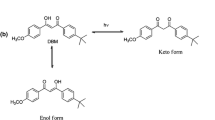Abstract
Two representatives of water-insoluble UV absorbers ( 3-(4-methylbenzilidene)camphor and 2-hydroxy-4-methoxybenzophenon ), different in their chemical structure, could be solubilized by two pairs of studied CDs (BCD, GCD, RAMEB, AcGCD). The substituted CD entities were markedly more effective solubilizers than the unsubstituted ones. The rate of photofading of an aqueous azoreactive dye solution was significantly increased in the presence of the substituted CDs. Mixing UV absorbers, solubilized by the mentioned CDs, to the aqueous dye solution marked deceleration in photofading could be achieved.
Similar content being viewed by others
References
Allen, N.S., Photofading mechanisms of dyes in solution and polymer media,Rev. Prog. Coloration,17, 61–71 (1987)
Szejtli, J., Cyclodextrin Technology, Kluwer Academic Publishers, Dodrecht, 1988
Author information
Authors and Affiliations
Rights and permissions
About this article
Cite this article
Rémi, E., Fenyves, É., Rusznák, I. et al. The action of lipophilic UV absorbers — solubilized by cyclodextrin — on photofading of aqueous solution of azoreactive dyes. J Incl Phenom Macrocycl Chem 25, 203–207 (1996). https://doi.org/10.1007/BF01041569
Issue Date:
DOI: https://doi.org/10.1007/BF01041569




